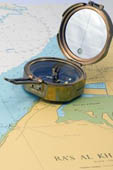
Purpose
To demonstrate the earth's magnetic force by creating our very own compass in a jar.
Additional information
A compass is an instrument used for navigation relative to the earths magnetic poles. It's magnetized pointer aligns itself to the earths magnetic field to calculate heading, allowing for safer and more efficient maritime travel. Compasses are often built as stand alone instruments, sealed with a magnetized bar and freely turning needle upon a pivot. Most compasses highlight the four cardinal directions or cardinal points of north, south, east, and west.
Sponsored Links
Required materials
- Needle
- Magnet
- Scissors
- Small piece of card
- Jar
- Thread
- Pencil
- Compass
Estimated Experiment Time
Approximately 15 to 20 minutes
Step-By-Step Procedure
- 1. Stroke the needle with the magnet several times to give it a magnetic charge.
- 2. Tie one end of the thread to the small piece of card and the other to the center of the pencil. Tying the thread to the card can be tricky, but carefully poke a small whole into the top end of the card that's just wide enough to run the thread through. Loop it around the card and tie in a knot.
- 3. Push the needle through the center of the card, stop when the needle is dead-center in the middle of the card.
- 4. Suspend the piece of card inside the jar by laying the pencil across the mouth of the jar so the card is dangling in the center of the jar. Do not allow the card to hit the bottom of the jar!
- 5. The needle should lie horizontally. Make sure to get the middle of the needle to rest in the middle of the card.
- 6. Place the jar on a flat surface next to your compass and leave it to stand freely. The needle in the jar should point in the same direction as your compass.
Note
Setting up the jar compass can be tricky the first time. You can refer to the following figure to get a general idea on how your compass should be set-up.
Observation
What happens when you turn your compass and your jar in another direction? Does the needle in your jar point in the same direction as your compass?
If your needle doesn't seem to be spinning with your compass, you may need to re-magnetize it.
Result
The magnetized needle is free to turn on its own and will always point north and south. The needle is acting as a magnet and is attracted to the earth’s magnetic force.
Sponsored Links
Take a moment to visit our table of Periodic Elements page where you can get an in-depth view of all the elements,
complete with the industry first side-by-side element comparisons!